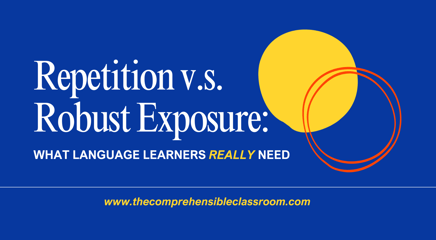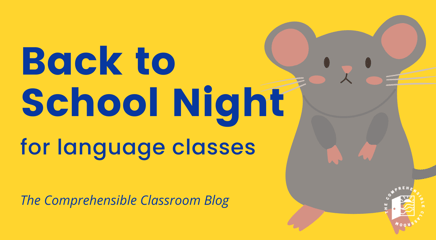If you haven't noticed, I've been trying to use more authentic listening texts lately :) Well, I was, until the school year ended. While I was out on maternity leave, my awesome substitute was a native speaker from Puerto Rico. My students were overwhelmed (and discouraged) listening to her speak in Spanish, and became whiney about how it was her fault that they didn't understand what she said because "she talks too fast!". The fault was not hers, but my own for over-sheltering my students. I speak much more s.l.o.w.l.y. and with learned gestures and lots of pausing and pointing. I stand by my method because my students are able to acquire the language that I use instead of just make sense of it. However, I've realized that I would be foolish to shelter them completely from authentic speech because, well, they're going to have to understand a "real" Spanish speaker someday! It would also be wise for me to expose them to the wide range of accents and rhythms and tones that can be heard in different people's speech. These are all things that I know--that I have known--but it is so easy to get caught up in the routine of teaching. When I began TPRSing, I had to focus so much of my attention and effort on developing the skills of questioning and circling, and the new methods like storytelling and LOTS of reading that everything else got pushed to the back of my mind. Isn't it frustrating how that happens? It is for this reason that I am thankful for Twitter and our Anchorage TPRS group and my blogroll, because I am constantly reminded of things that I've forgotten. Anyway, rabbit-trailing... It is not easy to find listening texts that are entirely comprehensible to my students, but they are out there and can be found with creative googling and rabbit trailing. More often than not, my students are able to describe the main idea of an authentic listening text to me without guidance, but they need specific, guided questions in order to pull out more detailed information (they have to know what they are listening for in order to hear it). Those are the kinds of tasks that I assign for summative assessments. To prepare for summative assessments, we do some of the same kinds of activities with which students will be assessed, but we also do activities like unscrambling the text and CLOZE passages. These activities do not require the students to demonstrate their listening comprehension, but they are good opportunities for students to get used to matching authentic speech with the written word. They become accustomed to the speed, rhythm, and flow of the language, learn to differentiate between fillers (em, bueno, pues) and the actual "meat" of the text, and observe the way that different accents and dialects give new life to the written word. From an administrative perspective, they are great activities because they don't take much time, don't need to be graded, and offer a lovely break from the daily grind for students. They are also excellent confidence boosters, because students are so proud of themselves when they are able to complete the activity with moderate to high success because they feel so overwhelmed when the first few words begin flying off the speaker's lips. It was a challenge, but they did it! Amy Lenord is the curator for this fantastic Wiki of authentic resources in Spanish. It contains reading texts as well as audio and visual texts, and it is a great starting point for anyone searching for authentic resources about any given topic in Spanish.
More from the blog
View Blog-

First we learn to listen
Aug 25, 2015 -

Repetition v.s. Robust Exposure
Sep 21, 2025Discover why repetition alone doesn’t lead to fluency and how robust exposure creates the right conditions for real language acquisition.
-

A Mouse Story for Back to School Night
Sep 7, 2025Discover a fun bilingual mouse folktale for Back to School Night. Engage parents, showcase storytelling, and highlight the power of language learning.
